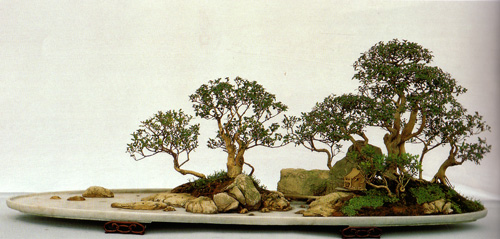
Using figurines in tray plantings doesn’t necessarily qualify as eccentric; it’s common in Chinese (and other) penjing plantings. Perhaps it’s the type (you don’t see many moose in China) and especially the relative size of the figurine that makes this trident maple planting unusual. This photo is from an article by Randy Clark entitled ‘Bonsai & Figurines’ that originally appeared in Bonsai Today issue 95. Randy Clark is the owner of the Bonsai Learning Center.
The Japanese seldom use them…
…. but the Chinese (and some others) often do. When it comes to figurines, basically its: penjing ‘yes’, Japanese bonsai ‘no,’ (the exception is very small figures used in some Japanese saikei) and Randy Clark’s ‘why not explore the issue?’ Most people I know are somewhere past ‘why not’ and leaning towards ‘just say no.’
Indiscriminate use
If you are like most serious Western bonsai enthusiasts, you usually avoid figurines. This is probably due to the fact that Japanese bonsai has enjoyed an earlier and stronger influence in the West than Chinese penjing. And the rampant and indiscriminate use of poorly made figurines in cheap (but overpriced) commercial bonsai hasn’t helped. Besides, when it comes to quality bonsai, ‘why gild the lily?’ might be a question worth asking.

This penjing by Quinquan Zhao. It’s from his benchmark book, Penjing: Worlds of Wonderment.The little hut that almost disappears into the landscape is the only figurine (?) I can see. This unobtrusive blending is a way to create a sense of scale. When you notice the hut, suddenly the whole arrangement becomes much larger.

Another of Randy Clark’s plantings (from Bonsai Today issue 95). The bear is proportionally much larger than the humans, animals and other man made elements in most penjing plantings. So much larger, that it becomes the focal point of the composition.